Engine PONTIAC GRAND PRIX 1998 User Guide
[x] Cancel search | Manufacturer: PONTIAC, Model Year: 1998, Model line: GRAND PRIX, Model: PONTIAC GRAND PRIX 1998Pages: 402, PDF Size: 17.96 MB
Page 97 of 402
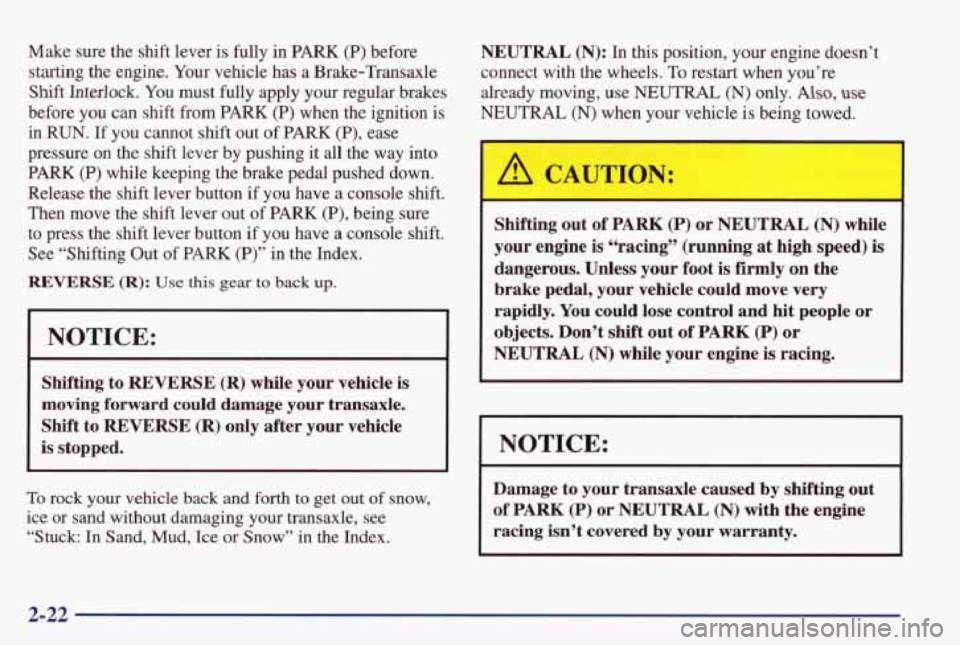
Make sure the shift lever is fully in PARK (P) before
starting the engine. Your vehicle has a Brake-Transaxle
Shift Interlock. You must fully apply your regular brakes
before
you can shift from PARK (P) when the ignition is
in RUN. If you cannot shift out
of PARK (P), ease
pressure on the shift lever by pushing it all the way into
PARK
(P) while keeping the brake pedal pushed down.
Release the shift lever button
if you have a console shift.
Then move the shift lever out
of PARK (P), being sure
to press the shift lever button
if you have a console shift.
See “Shifting Out of PARK
(P)” in the Index.
REVERSE (R): Use this gear to back up.
NOTICE:
Shifting to REVERSE (R) while your vehicle is
moving forward could damage your transaxle.
Shift to REVERSE (R) only after your vehicle
is stopped.
To rock your vehicle back and forth to get out of snow,
ice or sand without damaging your transaxle, see
“Stuck: In Sand, Mud, Ice or Snow” in the Index. NEUTRAL
(N): In
this position, your engine doesn’t
connect with the wheels. To restart when you’re
already moving, use NEUTRAL
(N) only. Also, use
NEUTRAL (N) when your vehicle is being towed.
I
I
A CAUTION: I
Shifting out of PARK (P) or NEUTRAL (N) while
your engine is “racing” (running at high speed) is
dangerous. Unless your
foot is firmly on the
brake pedal, your vehicle could move very
rapidly. You could lose control and hit people or
objects. Don’t shift out of PARK
(P) or
NEUTRAL
(N) while your engine is racing.
NOTICE:
Damage to your transaxle caused by shifting out
of PARK (P) or NEUTRAL (N) with the engine
racing isn’t covered by your warranty.
2-22
Page 99 of 402

SECOND (2): This position gives you more power, but
lower fuel economy. You can use
SECOND (2) on hills.
It can help control your speed as you go down steep
mountain roads, but then you would also want
to use
your brakes off and
on.
NOTICE:
.
Don’t drive in SECOND (2) for more than
25 miles (40 km) at speeds over 55 mph
(88 km/h), or you can damage your transaxle.
Use AUTOMATIC OVERDRIVE (D) or
THIRD (3) as much as possible.
Don’t shift into
SECOND (2) unless you are going
slower than
65 mph (105 km/h), or you can
damage your engine. FIRST
(1): This position gives you even more power,
but lower fuel economy than
SECOND (2). You can use
it
on very steep hills, or in deep snow or mud. If the shift
lever is put in FIRST (1)’ the transaxle won’t shift into
first gear until the vehicle is going slowly enough.
NOTICE:
If your front wheels can’t rotate, don’t try to
drive. This might happen
if you were stuck in
very deep sand or mud or were up against a solid
object. You could damage your transaxle.
Also, if you stop when going uphill, don’t hold
your vehicle there with only the accelerator
pedal. This could overheat and damage the
transaxle. Use your brakes or shift into
PARK (P)
to hold your vehicle in position on a hill.
2-24
Page 101 of 402
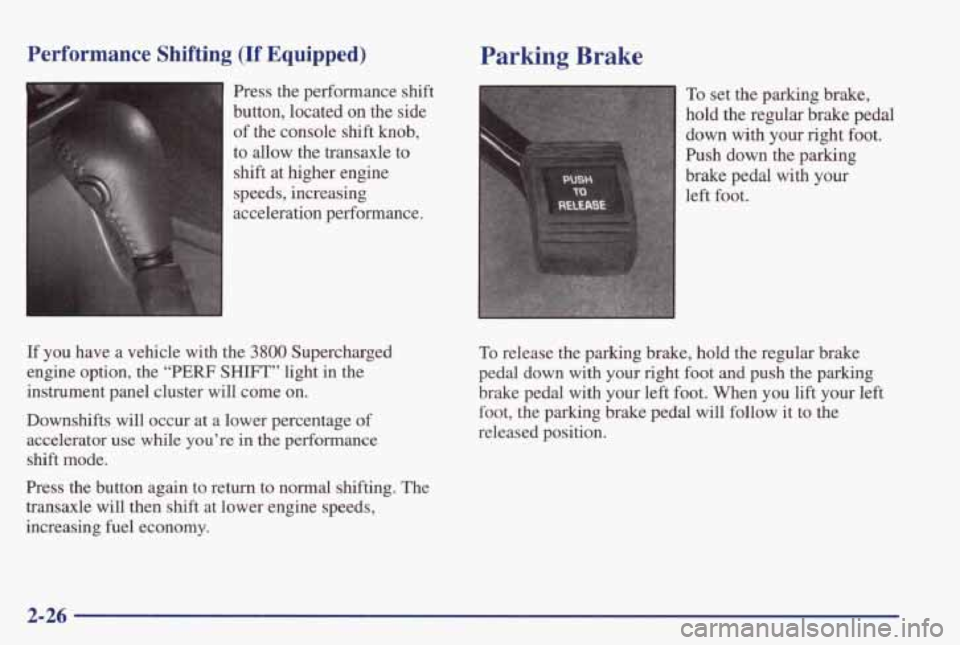
Performance Shifting (If Equipped)
1 Press the performance shift
button, located
on the side
of the console shift knob,
to allow the transaxle to
shift
at higher engine
speeds, increasing
acceleration performance.
If you have a vehicle with the
3800 Supercharged
engine option, the
“PERF SHIFT” light in the
instrument panel cluster will come on.
Downshifts will occur at a lower percentage of
accelerator use while you’re
in the performance
shift mode.
Press the button again to return to normal shifting. The
transaxle
will then shift at lower engine speeds,
increasing fuel economy.
Parking Brake
To set the parking brake,
hold the regular brake pedal
down with your right foot.
Push down the parking
brake pedal with
your
left foot.
To release the parking brake, hold the regular brake
pedal down with your right foot and push the parking
brake pedal with your left foot. When you lift your left
foot, the parking brake pedal will follow it to the
released position.
2-26
Page 102 of 402
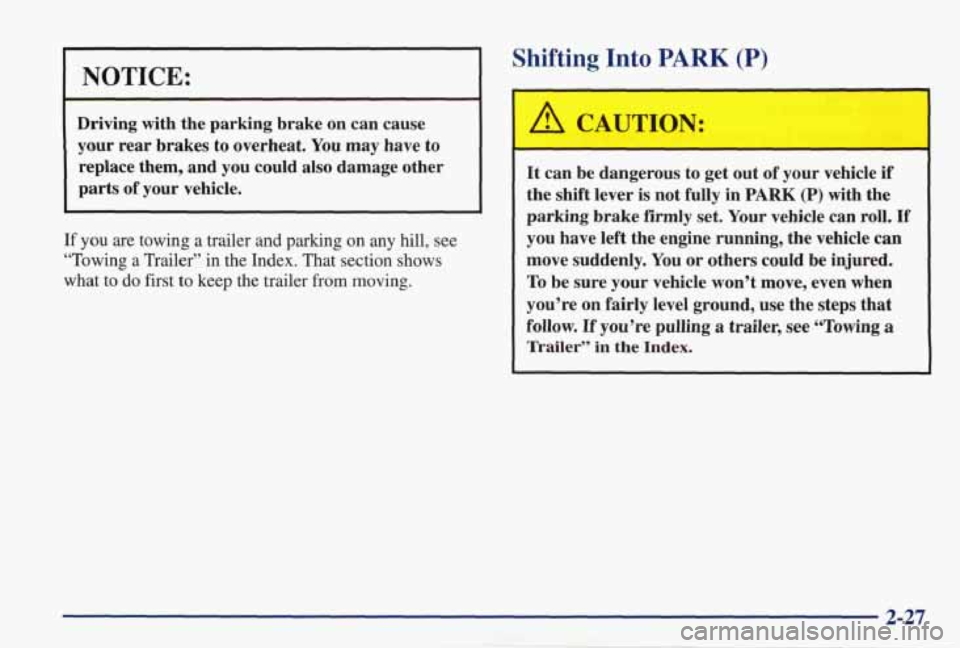
I NOTICE:
~ ~ ~
Driving with the parking brake on can cause
your rear brakes to overheat. You may have to
replace them, and you could also damage other
parts of your vehicle.
If you are towing a trailer and parking on any hill, see
“Towing a Trailer”
in the Index. That section shows
what to do first to keep the trailer from moving.
Shifting Into PARK (P)
A CAUTION:
It can be dangerous to get out of your vehicle if
the shift lever is not fully in
PARK (P) with the
parking brake
firmly set. Your vehicle can roll. If
you have left the engine running, the vehicle can
move suddenly. You or others could be injured.
To be sure your vehicle won’t move, even when
you’re on fairly level ground, use the steps that
follow.
If you’re pulling a trailer, see “Towing a
Trailer” in the Index.
Page 104 of 402

Console Shift
1. Hold the brake pedal down with your right foot and
2. Move the shift lever into PARK (P) position
set
the parking brake.
like this:
0 Hold in the button, located on the front of the
0 Push the shift knob all the way toward the front
shift
knob.
of your vehicle.
3. Turn the ignition key to LOCK.
4. Remove the key and take
it with you. If you can
leave
your vehicle with the ignition key in your
hand,
your vehicle is in PARK (P).
Leaving Your Vehicle With the
Engine Running
I
r
1
A CAUTION:
It can be dangerous to leave your vehicle with the
engine running. Your vehicle could move
suddenly if the shift lever is not fully
in PARK (P)
with the parking brake firmly set. And, if you
leave the vehicle with the engine running, it could
overheat and even catch fire. You or others could
be injured. Don’t leave your vehicle with the
engine running unless you have to.
2-29
Page 105 of 402

If you have to leave your vehicle with the engine running,
be sure your vehicle is in
PARK (P) and your parking
brake is
firmy set before you leave it. After you’ve moved
the
shift lever into PARK (P) position, hold the regular
brake
pedal down. Then, see if you can move the shift
lever away from PARK (P) without first pulling it toward
you (or,
if you have a console shift lever, without first
pushing the button).
If you can, it means that the shift
lever wasn’t fully locked into PARK (P).
Torque Lock
If you are parking on a hill and you don’t shift your
transaxle into
PARK (P) properly, the weight of the
vehicle may put too much force on the parking pawl
in
the transaxle. You may find it difficult to pull the shift
lever out of
PARK (P). This is called “torque lock.” To
prevent torque lock, set the parking brake and then shift
into
PARK (P) properly before you leave the driver’s
seat.
To find out how, see “Shifting Into PARK (P)” in
the Index.
When you are ready to drive, move the shift lever out
of
PARK (P) before you release the parking brake.
If torque lock does occur, you may need to have another
vehicle push yours a little uphill to take some of the
pressure from the parking pawl in the transaxle,
so you
can pull the shift lever out
of PARK (P).
Shifting Out of PARK (P)
Your vehicle has a Brake-Transaxle Shift Interlock. You
must fully apply your regular brakes before you can
shift from PARK (P) when the ignition is in RUN. See
“Automatic Transaxle Operation” in the Index.
If you cannot shift out
of PARK (P), ease pressure on
the shift lever by pushing it all the way into PARK (P)
while keeping the brake pedal pushed down. Release the
shift lever button if you have a console shift. Then move
the shift lever out of
PARK (P), being sure to press the
shift lever button if you have a console shift.
If you ever hold the brake pedal down but still can’t
shift out of
PARK (P) with column shift, try this:
1. Turn the key to OFF.
2. Apply and hold the brake until the end of Step 4.
3. Shift to NEUTRAL (N).
4. Start the engine and shift to the drive gear you want.
5. Have the vehicle fixed as soon as you can.
With the console shift lever, see “Shift Lock Release”
earlier
in this section.
2-30
Page 106 of 402
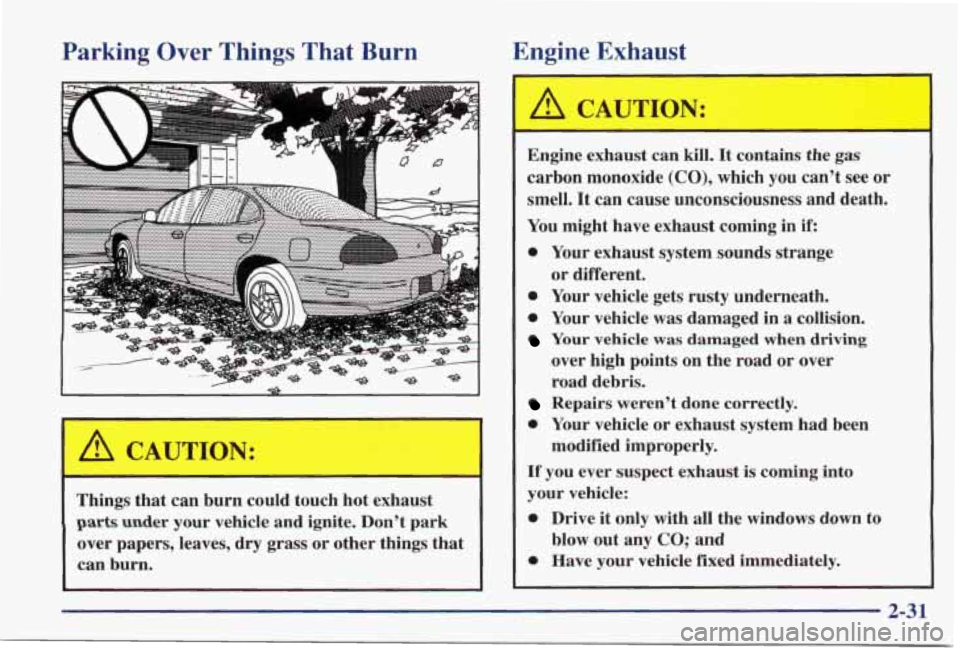
Parking Over Things '
.. . . .
& -"
---- e-" I
Things that can burn could touch hot exhaust
parts under your vehicle and ignite. Don't park
over papers, leaves, dry grass or other things that
can burn.
Engine Exhaust
Engine exhaust can kill. It contains the gas
carbon monoxide (CO), which you can't see or
smell. It can cause unconsciousness and death.
You might have exhaust coming in if:
0 Your exhaust system sounds strange
0 Your vehicle gets rusty underneath.
0 Your vehicle was damaged in a collision.
Your vehicle was damaged when driving
over high points on the road or over
road debris. or different.
Repairs weren't done correctly.
0 Your vehicle or exhaust system had been
If you ever suspect exhaust is coming into
your vehicle:
0 Drive it only with all the windows down to
0 Have your vehicle fixed immediately.
modified
improperly.
blow out any
CO; and
2-31
~~
Page 107 of 402
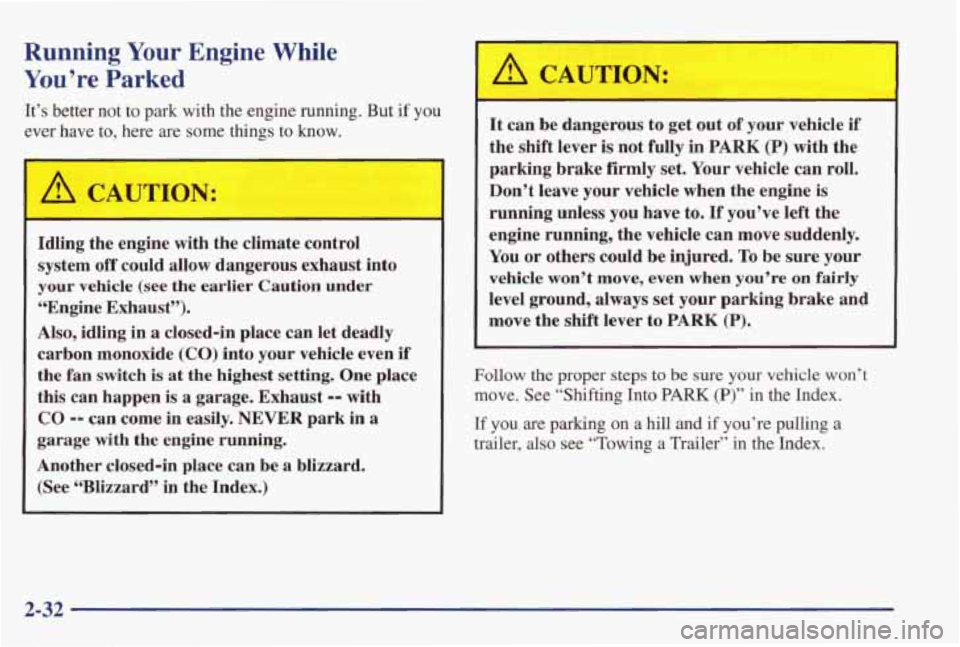
Running Your Engine While
You’re Parked
It’s better not to park with the engine running. But if you
ever have to, here are some things to know.
A CAUT’ IN:
Idling the engine with the climate control
system
off could allow dangerous exhaust into
your
vehicle (see the earlier Caution under
“Engine Exhaust”).
Also, idling in
a closed-in place can let deadly
carbon monoxide
(CO) into your vehicle even if
the fan switch is at the highest setting. One place
this can happen is a garage. Exhaust
-- with
CO -- can come in easily. NEVER park in a
garage with the engine running.
Another closed-in place can be a blizzard.
(See “Blizzard” in the Index.)
I
, A CAUTION:
It can be dangerous to get out of your vehicle if
the shift lever is not fully in
PARK (P) with the
parking brake firmly set. Your vehicle can roll.
Don’t leave your vehicle when the engine is
running unless you have to. If you’ve left the
engine running, the vehicle can move suddenly.
You or others could be injured.
To be sure your
vehicle won’t move, even when you’re on fairly
level ground, always set your parking brake and
move the shift lever to
PARK (P).
Follow the proper steps to be sure your vehicle won’t
move. See “Shifting Into PARK (P)” in the Index.
If you are parking on a hill and if you’re pulling a
trailer, also see “Towing a Trailer’’ in the Index.
2-32
Page 127 of 402
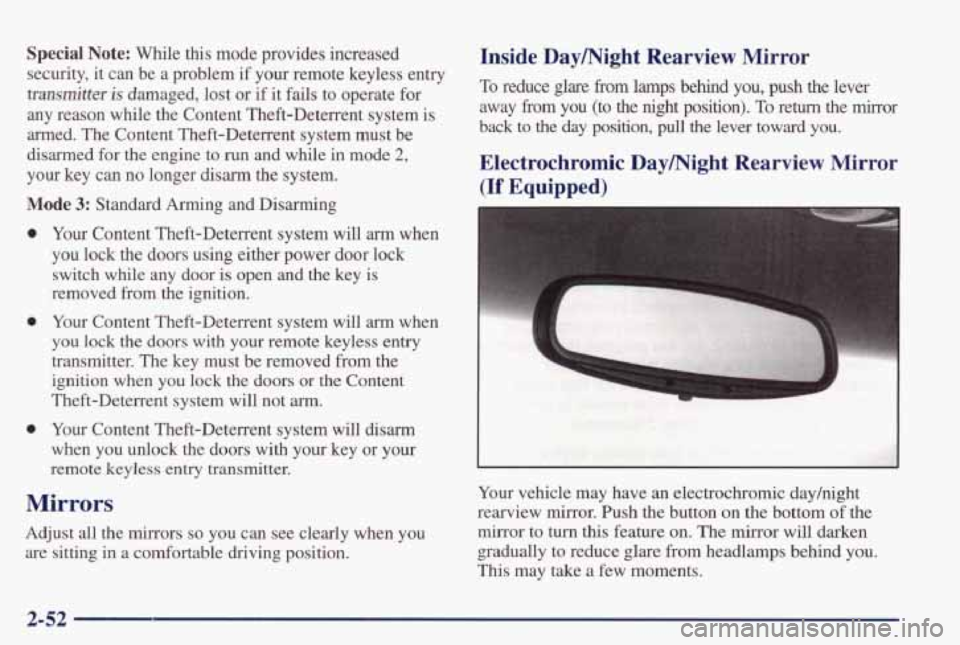
Special Note: While this mode provides increased
security, it can be a problem if your remote keyless entry
transmitter is damaged, lost or if it fails to operate for
any reason while the Content Theft-Deterrent system is
armed. The Content Theft-Deterrent system must be
disarmed for the engine to run and while in mode
2,
your key can no longer disarm the system.
Mode 3: Standard Arming and Disarming
0
0
0
Your Content Theft-Deterrent system will arm when
you lock the doors using either power door lock
switch while any door is open and the key is
removed from the ignition.
Your Content Theft-Deterrent system will arm when
you lock
the doors with your remote keyless entry
transmitter. The key must be removed from the
ignition when you lock
the doors or the Content
Theft-Deterrent system will not
arm.
Your Content Theft-Deterrent system will disarm
when you unlock
the doors with your key or your
remote keyless entry transmitter.
Mirrors
Adjust all the mirrors so you can see clearly when you
are sitting in a comfortable driving position.
Inside Daymight Rearview Mirror
To reduce glare from lamps behind you, push the lever
away from you (to
the night position). To return the mirror
back to the
day position, pull the lever toward you.
Electrochromic Daymight Rearview Mirror
(If Equipped)
Your vehicle may have an electrochromic dayhight
rearview mirror. Push the button on the bottom of the
mirror to
turn this feature on. The mirror will darken
gradually to reduce glare from headlamps behind you.
This may take a
few moments.
2-52
Page 138 of 402

SpeedometedOdometer
Your speedometer lets you see your speed in both miles
per hour (mph) and kilometers per hour
(km/h). Your
odometer shows how far your vehicle has been driven in
either miles (used in the United States) or in kilometers
(used in Canada).
Your vehicle has a tamper-resistant odometer.
If you see
silver lines between the numbers, you’ll
know someone
has probably tampered with it and the numbers may not
be correct.
You may wonder what happens
if your vehicle needs a
new odometer installed.
If the new one can be set to the
mileage
total of the old odometer, then that will be done.
If it can’t, then it will be set at zero and a label must be
put on the driver’s door to show the old mileage reading when the new odometer was installed.
Trip Odometer
Your trip odometer tells how far you have driven since
you last reset it.
To set it to zero, press the RESET
button on the right side of the instrument cluster.
Tachometer
I
The tachometer displays the engine speed in thousands
of revolutions per minute (rpm).
NOTICE:
Do not operate the engine with the tachometer in
the red area, or engine damage may occur.
i
2-63